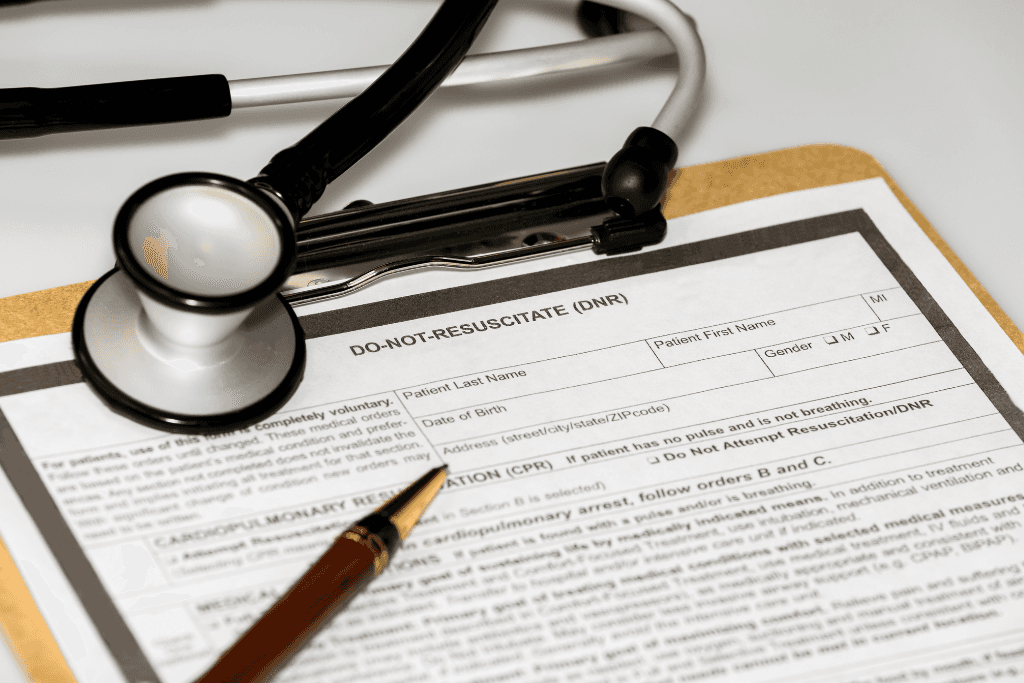You've decided to establish a do-not-resuscitate (DNR) order after consulting with your healthcare provider and completing all the necessary preparations. But now, how do you actually file it?
Filing your DNR is crucial to ensure your healthcare providers, first responders, and family are aware of your end-of-life wishes. In this guide, we’ll walk you through the steps to file your DNR, have it notarized, and update it if needed.
Key Takeaways
DNR forms can be obtained from your healthcare provider or hospice, or online.
To file your DNR, you must complete the form and ensure you include all required signatures from witnesses or have it notarized.
Some states require DNR forms to be registered via mail, fax, or online submission, so check the regulations in the state you reside in.
Steps to File a DNR Form

It’s important to note that you must use the correct DNR form because some states have different requirements, and what may be valid in one state may not be valid in another.
For example, in Texas, patients can wear medical jewelry like bracelets or necklaces instead of carrying their DNR forms, whereas other states may require patients to carry their DNR forms with them. If you’re traveling to a state with different requirements, you must redo your DNR in that state.
Once you’ve got the DNR, you will need to complete and file it so that it’s valid. To help you avoid any complications or miscommunications, here are the steps to follow to fill out and file your DNR.
Complete the DNR form: A DNR form is not the most complicated paperwork to complete. Generally, you’ll just include your full name, address, date of birth, a description of your medical condition, and your CPR preferences.
Sign the DNR form: Once you have filled out your details, you must sign the form with a date.
Obtain physician signatures: This is where you need to pay special attention to your state’s requirements. Depending on where you live, you will need to obtain your physician’s signature in order for your DNR to be valid.
Obtain signatures from witnesses: Again, depending on where you live, you may be required to get signatures from two witnesses who are not the hospital's employees. You might also have to get your DNR notarized to be considered valid. Check the requirements on your state’s website or chat with your healthcare provider.
Share copies of your DNR: It’s no good just to sign your DNR forms and then not distribute this information to the relevant parties. Share this information with your healthcare providers and close family members.
Register your DNR form: Some states have a registry where you can file your DNR, and it will be available immediately to first responders and other healthcare providers.
Once you fill out the form and fill it, you must keep it somewhere safe but still easily accessible to the people who need it. Trustworthy is your number one best place to keep your DNR safe. Trustworthy's award-winning Family Operating System® that manages all your estate planning in one secure location. With 256-bit AES encryption and two-factor authentication, Trustworthy is also HIPAA compliant.
Witnessing and Notarizing Your DNR Form
Some states require witnessing and notarizing, depending on where you live.
In the event that your DNR form requires signatures from two witnesses, these witnesses come with their own set of requirements. For example, they need to be impartial. This means they are not related to you, nor are they employees of the hospital or physicians. The purpose of these witnesses is to ensure you sign the document with a sound mind and that you are not coerced into signing a DNR.
In addition, instead of signatures, some states may require that your DNR form be notarized by a notary public. This is done to verify that the identity on the DNR form is correct and that you have made the choice yourself and have not been forced into it. This also adds another layer of legal authenticity to your DNR. You can typically find a notary at places like law offices and banks, as well as online.
Be sure to double-check the signature requirements of your state to ensure that your DNR is valid. Creating and filing a DNR can be an overwhelming experience, that’s why Trustworthy can connect you and your family members with a local Trustworthy Certified Expert™ to help you manage your end-of-life planning like DNRs.
How to Register Your DNR Form

This step is only applicable if your state requires it. To find out if your state has a DNR registry, you can search online or you can contact your state’s Department of Health for advice.
If your state does allow you to register your DNR, here’s what you’re going to need to do:
Submit the DNR form: Following the instructions on the registry, you will need to upload a copy of your DNR form. Often, this can be done via online submission, mail, or fax.
Obtain submission confirmation: Once you have uploaded your DNR form, you will likely receive some form of confirmation that your DNR has been registered and updated with the relevant healthcare providers and your medical record.
Keep your DNR registration up to date: If you make any changes or move to a different state, remember to update your registration to ensure your DNR is valid.
How to Talk About Your DNR Wishes with Family and Healthcare Providers
Talking with your family and healthcare providers is perhaps one of the hardest parts of the process. However, discussing your end-of-life wishes with your healthcare provider is the easiest of the two.
If you want to create a DNR, it’s important that you talk with your healthcare provider first and sooner rather than later. During your consultation, you can discuss your fears and reasons why you want a DNR. Many people with terminal illnesses wish to avoid aggressive life-saving methods that can sometimes leave them with traumatic injuries afterward. For example, sometimes CPR can result in painful injuries like broken ribs.
During this time, your healthcare provider will discuss all the risks and benefits of this decision to ensure that you are 100% certain. They’ll also ensure that you are making this decision because you want to and not because you feel pressured.
Discussing your DNR wishes with your family can be a little bit harder, but it’s important to do this as soon as possible so that everyone is aware of your end-of-life wishes. Start this conversation before a medical crisis arises, as you want it to take place when everyone is calm and collected.
During this discussion, it’s important that you be clear and honest about your reasons for wanting a DNR. Explain that you prefer to focus on quality of life rather than aggressive treatment, which, oftentimes does not actually extend your life that much longer. If you feel that your family may have a difficult time accepting your decision, you can have this conversation with your healthcare provider present so they can answer any questions your family will inevitably have.
It’s a good idea to keep a record of this conversation to prevent any confusion or miscommunication about your end-of-life wishes. You can store this document with Trustworthy and create a trusted network of people who have access to information at all times in case of an emergency.
How to Update or Cancel Your Do-Not-Resuscitate (DNR) Order

Remember, you have the right to revoke or change your DNR at any time. Just ensure you do it as soon as possible and update all the relevant people, including your family and healthcare providers.
Attorney John Strohmeyer of Strohmeyer Law in Houston explains: “Some things to remember are that this (your DNR) will stop physicians or other medical personnel from engaging in CPR, or cardiopulmonary resuscitation. They won’t use a defibrillator on you to restart your heart. They can’t do any advanced airway management to make sure that you’re breathing.”
So if you move to a different state or your medical condition changes, remember to update your DNR. To do this, you will need to fill out a new form and follow the same steps provided above.
Keep an updated copy of your DNR on Trustworthy and use the user access permissions to share this information with your trusted network of people. This way, they can have instant access wherever you or they are.
Frequently Asked Questions
Do I need a lawyer to fill out a DNR form?
No, however, you can use a lawyer to assist you with any legal questions you may have about estate planning.
What is the difference between a DNR form and other advance directives?
A DNR only applies to cardiopulmonary resuscitation (CPR) and other resuscitation methods. An advance directive is more broad and is written by the physician.
How do I ensure my DNR form is honored in an emergency?
You can ensure your DNR is honored during an emergency by keeping it somewhere easily accessible, like wearing medical jewelry or leaving a note on your refrigerator door.
We’d love to hear from you! Feel free to email us with any questions, comments, or suggestions for future article topics.
Trustworthy is an online service providing legal forms and information. We are not a law firm and do not provide legal advice.














